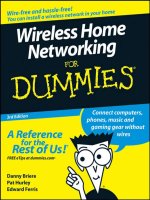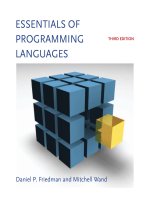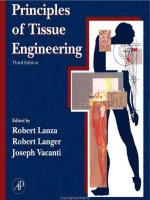essentials of programming languages 3rd edition apr 2008
Bạn đang xem bản rút gọn của tài liệu. Xem và tải ngay bản đầy đủ của tài liệu tại đây (3.41 MB, 433 trang )
ESSENTIALS OF
PROGRAMMING
LANGUAGES
Daniel P. Friedman and Mitchell Wand
THIRD EDITION
ESSENTIALS OF
PROGRAMMING LANGUAGES
THIRD EDITION
Friedman and Wand
MD DALIM 955472 3/22/08 CYAN MAG YELO BLACK
computer science/programming languages
Essentials of Programming Languages
third edition
Daniel P. Friedman and Mitchell Wand
This book provides students with a deep, working understanding of the essential concepts of program-
ming languages. Most of these essentials relate to the semantics, or meaning, of program elements,
and the text uses interpreters (short programs that directly analyze an abstract representation of the
program text) to express the semantics of many essential language elements in a way that is both clear
and executable. The approach is both analytical and hands-on. The book provides views of program-
ming languages using widely varying levels of abstraction, maintaining a clear connection between the
high-level and low-level views. Exercises are a vital part of the text and are scattered throughout; the text
explains the key concepts, and the exercises explore alternative designs and other issues. The complete
Scheme code for all the interpreters and analyzers in the book can be found online through The MIT
Press website.
For this new edition, each chapter has been revised and many new exercises have been added.
Significant additions have been made to the text, including completely new chapters on modules and
continuation-passing style. Essentials of Programming Languages can be used for both graduate and un-
dergraduate courses, and for continuing education courses for programmers.
Daniel P. Friedman is Professor of Computer Science at Indiana University and is the author of many
books published by The MIT Press, including The Little Schemer (fourth edition, 1995), The Seasoned
Schemer (1995), A Little Java, A Few Patterns (1997), each of these coauthored with Matthias Felleisen,
and The Reasoned Schemer (2005), coauthored with William E. Byrd and Oleg Kiselyov. Mitchell Wand is
Professor of Computer Science at Northeastern University.
“With lucid prose and elegant code, this book provides the most concrete introduction to the few build-
ing blocks that give rise to a wide variety of programming languages. I recommend it to my students and
look forward to using it in my courses.”
—Chung-chieh Shan, Department of Computer Science, Rutgers University
“Having taught from EOPL for several years, I appreciate the way it produces students who understand
the terminology and concepts of programming languages in a deep way, not just from reading about the
concepts, but from programming them and experimenting with them. This new edition has an increased
emphasis on types as contracts for defining procedure interfaces, which is quite important for many
students.”
—Gary T. Leavens, School of Electrical Engineering and Computer Science, University of Central Florida
“I’ve found the interpreters-based approach for teaching programming languages to be both compelling
and rewarding for my students. Exposing students to the revelation that an interpreter for a program-
ming language is itself just another program opens up a world of possibilities for problem solving. The
third edition of Essentials of Programming Languages makes this approach of writing interpreters more
accessible than ever.”
—Marc L. Smith, Department of Computer Science, Vassar College
The MIT Press
Massachusetts Institute of Technology
Cambridge, Massachusetts 02142
978-0-262-06279-4
Essentials of
Programming
Languages
third edition
Essentials of
Programming
Languages
third edition
Daniel P. Friedman
Mitchell Wand
The MIT Press
Cambridge, Massachusetts
London, England
© 2008 Daniel P. Friedman and Mitchell Wand
All rights reserved. No part of this book may be reproduced in any form by any
electronic or mechanical means (including photocopying, recording, or information
storage and retrieval) without permission in writing from the publisher.
MIT Press books may be purchased at special quantity discounts for business or sales
promotional use. For information, please email or
write to Special Sales Department, The MIT Press, 55 Hayward Street, Cambridge,
MA 02142.
This book was set in L
A
T
E
X2
ε
by the authors, and was printed and bound in the United
States of America.
Library of Congress Cataloging-in-Publication Data
Friedman, Daniel P.
Essentials of programming languages / Daniel P. Friedman, Mitchell
Wand.
—3rd ed.
p. cm.
Includes bibliographical references and index.
ISBN 978-0-262-06279-4 (hbk. : alk. paper)
1. Programming Languages (Electronic computers). I. Wand,
Mitchell. II. Title.
QA76.7.F73 2008
005.1—dc22 2007039723
10987654321
Contents
Foreword by Hal Abelson ix
Preface xv
Acknowledgments xxi
1 Inductive Sets of Data 1
1.1 Recursively Specified Data 1
1.2 Deriving Recursive Programs 12
1.3 Auxiliary Procedures and Context Arguments 22
1.4 Exercises 25
2 Data Abstraction 31
2.1 Specifying Data via Interfaces 31
2.2 Representation Strategies for Data Types 35
2.3 Interfaces for Recursive Data Types 42
2.4 A Tool for Defining Recursive Data Types 45
2.5 Abstract Syntax and Its Representation 51
3 Expressions 57
3.1 Specification and Implementation Strategy 57
3.2 LET: A Simple Language 60
3.3 PROC: A Language with Procedures 74
3.4 LETREC: A Language with Recursive Procedures 82
3.5 Scoping and Binding of Variables 87
3.6 Eliminating Variable Names 91
3.7 Implementing Lexical Addressing 93
vi Contents
4 State 103
4.1 Computational Effects 103
4.2 EXPLICIT-REFS: A Language with Explicit References 104
4.3 IMPLICIT-REFS: A Language with Implicit References 113
4.4 MUTABLE-PAIRS: A Language with Mutable Pairs 124
4.5 Parameter-Passing Variations 130
5 Continuation-Passing Interpreters 139
5.1 A Continuation-Passing Interpreter 141
5.2 A Trampolined Interpreter 155
5.3 An Imperative Interpreter 160
5.4 Exceptions 171
5.5 Threads 179
6 Continuation-Passing Style 193
6.1 Writing Programs in Continuation-Passing Style 193
6.2 Tail Form 203
6.3 Converting to Continuation-Passing Style 212
6.4 Modeling Computational Effects 226
7Types 233
7.1 Values and Their Types 235
7.2 Assigning a Type to an Expression 238
7.3 CHECKED: A Type-Checked Language 240
7.4 INFERRED: A Language with Type Inference 248
8 Modules 275
8.1 The Simple Module System 276
8.2 Modules That Declare Types 292
8.3 Module Procedures 311
9 Objects and Classes 325
9.1 Object-Oriented Programming 326
9.2 Inheritance 329
9.3 The Language 334
9.4 The Interpreter 336
9.5 A Typed Language 352
9.6 The Type Checker 358
Contents vii
A For Further Reading 373
B The SLLGEN Parsing System 379
B.1 Scanning 379
B.2 Parsing 382
B.3 Scanners and Parsers in SLLGEN 383
Bibliography 393
Index 401
Foreword
This book brings you face-to-face with the most fundamental idea in com-
puter programming:
The interpreter for a computer language is j ust another program.
It sounds obvious, doesn’t it? But the implications are profound. If you
are a computational theorist, the interpreter idea recalls Gödel’s discovery
of the limitations of formal logical systems, Turing’s concept of a universal
computer, and von Neumann’s basic notion of the stored-program machine.
If you are a programmer, mastering the idea of an interpreter is a source of
great power. It provokes a real shift in mindset, a basic change in the way
you think about programming.
I did a lot of programming before I learned about interpreters, and I pro-
duced some substantial programs. One of them, for example, was a large
data-entry and information-retrieval system written in PL/I. When I imple-
mented my system, I viewed PL/I as a fixed collection of rules established
by some unapproachable group of language designers. I saw my job as not
to modify these rules, or even to understand them deeply, but rather to pick
through the (very) large manual, selecting this or that feature to use. The
notion that there was some underlying structure to the way the language was
organized, and that I might want to override some of the language design-
ers’ decisions, never occurred to me. I didn’t know how to create embedded
sublanguages to help organize my implementation, so the entire program
seemed like a large, complex mosaic, where each piece had to be carefully
shaped and fitted into place, rather than a cluster of languages, where the
pieces could be flexibly combined. If you don’t understand interpreters, you
can still write programs; you can even be a competent programmer. But you
can’t be a master.
x Foreword
There are three reasons why as a programmer you should learn about
interpreters.
First, you will need at some point to implement interpreters, perhaps not
interpreters for full-blown general-purpose languages, but interpreters just
the same. Almost every complex computer system with which people inter-
act in flexible ways—a computer drawing tool or an information-retrieval
system, for example—includes some sort of interpreter that structures the
interaction. These programs may include complex individual operations—
shading a region on the display screen, or performing a database search—
but the interpreter is the glue that lets you combine individual operations
into useful patterns. Can you use the result of one operation as the input to
another operation? Can you name a sequence of operations? Is the name
local or global? Can you parameterize a sequence of operations, and give
names to its inputs? And so on. No matter how complex and polished the
individual operations are, it is often the quality of the glue that most directly
determines the power of the system. It’s easy to find examples of programs
with good individual operations, but lousy glue; looking back on it, I can see
that my PL/I database program certainly had lousy glue.
Second, even programs that are not themselves interpreters have impor-
tant interpreter-like pieces. Look inside a sophisticated computer-aided
design system and you’re likely to find a geometric recognition language, a
graphics interpreter, a rule-based control interpreter, and an object-oriented
language interpreter all working together. One of the most powerful ways
to structure a complex program is as a collection of languages, each of which
provides a different perspective, a different way of working with the pro-
gram elements. Choosing the right kind of language for the right purpose,
and understanding the implementation tradeoffs involved: that’s what the
study of interpreters is about.
The third reason for learning about interpreters is that programming tech-
niques that explicitly involve the structure of language are becoming increas-
ingly important. Today’s concern with designing and manipulating class
hierarchies in object-oriented systems is only one example of this trend. Per-
haps this is an inevitable consequence of the fact that our programs are
becoming increasingly complex—thinking more explicitly about languages
may be our best tool for dealing with this complexity. Consider again the
basic idea: the interpreter itself is just a program. But that program is writ-
ten in some language, whose interpreter is itself just a program written
in some language whose interpreter is itself
Perhaps the whole distinc-
tion between program and programming language is a misleading idea, and
Foreword xi
future programmers will see themselves not as writing programs in particu-
lar, but as creating new languages for each new application.
Friedman and Wand have done a landmark job, and their book will change
the landscape of programming-language courses. They don’t just tell you
about interpreters; they show them to you. The core of the book is a tour de
force sequence of interpreters starting with an abstract high-level language
and progressively making linguistic features explicit until we reach a state
machine. You can actually run this code, study and modify it, and change the
way these interpreters handle scoping, parameter-passing, control structure,
etc.
Having used interpreters to study the execution of languages, the authors
show how the same ideas can be used to analyze programs without run-
ning them. In two new chapters, they show how to implement type checkers
and inferencers, and how these features interact in modern object-oriented
languages.
Part of the reason for the appeal of this approach is that the authors have
chosen a good tool—the Scheme language, which combines the uniform syn-
tax and data-abstraction capabilities of Lisp with the lexical scoping and
block structure of Algol. But a powerful tool becomes most powerful in the
hands of masters. The sample interpreters in this book are outstanding mod-
els. Indeed, since they are runnable models, I’m sure that these interpreters
and analyzers will find themselves at the cores of many programming sys-
tems over the coming years.
This is not an easy book. Mastery of interpreters does not come easily,
and for good reason. The language designer is a further level removed from
the end user than is the ordinary application programmer. In designing an
application program, you think about the specific tasks to be performed, and
consider what features to include. But in designing a language, you consider
the various applications people might want to implement, and the ways in
which they might implement them. Should your language have static or
dynamic scope, or a mixture? Should it have inheritance? Should it pass
parameters by reference or by value? Should continuations be explicit or
implicit? It all depends on how you expect your language to be used, which
kinds of programs should be easy to write, and which you can afford to make
more difficult.
Also, interpreters really are subtle programs. A simple change to a line of
code in an interpreter can make an enormous difference in the behavior of
the resulting language. Don’t think that you can just skim these programs—
very few people in the world can glance at a new interpreter and predict
xii Foreword
from that how it will behave even on relatively simple programs. So study
these programs. Better yet, run them—this is working code. Try interpreting
some simple expressions, then more complex ones. Add error messages.
Modify the interpreters. Design your own variations. Try to really master
these programs, not just get a vague feeling for how they work.
If you do this, you will change your view of your programming, and your
view of yourself as a programmer. You’ll come to see yourself as a designer
of languages rather than only a user of languages, as a person who chooses
the rules by which languages are put together, rather than only a follower of
rules that other people have chosen.
Postscript to th e Third Edition
The foreword above was written only seven years ago. Since then, informa-
tion applications and services have entered the lives of people around the
world in ways that hardly seemed possible in 1990. They are powered by
an ever—growing collection of programming languages and programming
frameworks—all erected on an ever-expanding platform of interpreters.
Do you want to create Web pages? In 1990, that meant formatting static
text and graphics, in effect, creating a program to be run by browsers exe-
cuting only a single “print” statement. Today’s dynamic Web pages make
full use of scripting languages (another name for interpreted languages) like
Javascript. The browser programs can be complex, and including asyn-
chronous calls to a Web server that is typically running a program in a com-
pletely different programming framework possibly with a host of services,
each with its own individual language.
Or you might be creating a bot for enhancing the performance of your
avatar in a massive online multiplayer game like World of Warcraft. In that
case, you’re probably using a scripting language like Lua, possibly with an
object-oriented extension to help in expressing classes of behaviors.
Or maybe you’re programming a massive computing cluster to do index-
ing and searching on a global scale. If so, you might be writing your pro-
grams using the map-reduce paradigm of functional programming to relieve
you of dealing explicitly with the details of how the individual processors are
scheduled.
Foreword xiii
Or perhaps you’re developing new algorithms for sensor networks, and
exploring the use of lazy evaluation to better deal with parallelism and data
aggregation. Or exploring transformation systems like XSLT for controlling
Web pages. Or designing frameworks for transforming and remixing multi-
media streams. Or . . .
So many new applications! So many new languages! So many new inter-
preters!
As ever, novice programmers, even capable ones, can get along viewing
each new framework individually, working within its fixed set of rules. But
creating new frameworks requires skills of the master: understanding the
principles that run across languages, appreciating which language features
are best suited for which type of application, and knowing how to craft the
interpreters that bring these languages to life. These are the skills you will
learn from this book.
Hal Abelson
Cambridge, Massachusetts
September 2007
Preface
Goal
This book is an analytic study of programming languages. Our goal is to
provide a deep, working understanding of the essential concepts of program-
ming languages. These essentials have proved to be of enduring importance;
they form a basis for understanding future developments in programming
languages.
Most of these essentials relate to the semantics, or meaning, of program
elements. Such meanings reflect how program elements are interpreted as
the program executes. Programs called interpreters provide the most direct,
executable expression of program semantics. They process a program by
directly analyzing an abstract representation of the program text. We there-
fore choose interpreters as our primary vehicle for expressing the semantics
of programming language elements.
The most interesting question about a program as object is, “What does it
do?” The study of interpreters tells us this. Interpreters are critical because
they reveal nuances of meaning, and are the direct path to more efficient
compilation and to other kinds of program analyses.
Interpreters are also illustrative of a broad class of systems that transform
information from one form to another based on syntax structure. Compil-
ers, for example, transform programs into forms suitable for interpretation
by hardware or virtual machines. Though general compilation techniques
are beyond the scope of this book, we do develop several elementary pro-
gram translation systems. These reflect forms of program analysis typical
of compilation, such as control transformation, variable binding resolution,
and type checking.
xvi Preface
The following are some of the strategies that distinguish our approach.
1. Each new concept is explained through the use of a small language. These
languages are often cumulative: later languages may rely on the features
of earlier ones.
2. Language processors such as interpreters and type checkers are used to
explain the behavior of programs in a given language. They express lan-
guage design decisions in a manner that is both formal (unambiguous and
complete) and executable.
3. When appropriate, we use interfaces and specifications to create data
abstractions. In this way, we can change data representation without
changing programs. We use this to investigate alternative implementa-
tion strategies.
4. Our language processors are written both at the very high level needed to
produce a concise and comprehensible view of semantics and at the much
lower level needed to understand implementation strategies.
5. We show how simple algebraic manipulation can be used to predict the
behavior of programs and to derive their properties. In general, however,
we make little use of mathematical notation, preferring instead to study
the behavior of programs that constitute the implementations of our lan-
guages.
6. The text explains the key concepts, while the exercises explore alternative
designs and other issues. For example, the text deals with static binding,
but dynamic binding is discussed in the exercises. One thread of exer-
cises applies the concept of lexical addressing to the various languages
developed in the book.
We provide several views of programming languages using widely vary-
ing levels of abstraction. Frequently our interpreters provide a very high-
level view that expresses language semantics in a very concise fashion, not
far from that of formal mathematical semantics. At the other extreme, we
demonstrate how programs may be transformed into a very low-level form
characteristic of assembly language. By accomplishing this transformation
in small stages, we maintain a clear connection between the high-level and
low-level views.
Preface xvii
We have made some significant changes to this edition. We have includ-
ed informal contracts with all nontrivial definitions. This has the effect of
clarifying the chosen abstractions. In addition, the chapter on modules is
completely new. To make implementations simpler, the source language for
chapters 3, 4, 5, 7, and 8 assumes that exactly one argument can be passed
to a function; we have included exercises that support multiargument pro-
cedures. Chapter 6 is completely new, since we have opted for a first-order
compositional continuation-passing-style transform rather than a relational
one. Also, because of the nature of tail-form expressions, we use multiargu-
ment procedures here, and in the objects and classes chapter, we do the same,
though there it is not so necessary. Every chapter has been revised and many
new exercises have been added.
Organization
The first two chapters provide the foundations for a careful study of pro-
gramming languages. Chapter 1 emphasizes the connection between induc-
tive data specification and recursive programming and introduces several
notions related to the scope of variables. Chapter 2 introduces a data type
facility. This leads to a discussion of data abstraction and examples of repre-
sentational transformations of the sort used in subsequent chapters.
Chapter 3 uses these foundations to describe the behavior of programming
languages. It introduces interpreters as mechanisms for explaining the run-
time behavior of languages and develops an interpreter for a simple, lexically
scoped language with first-class procedures and recursion. This interpreter is
the basis for much of the material in the remainder of the book. The chapter
ends by giving a thorough treatment of a language that uses indices in place
of variables and as a result variable lookup can be via a list reference.
Chapter 4 introduces a new component, the state, which maps locations
to values. Once this is added, we can look at various questions of represen-
tation. In addition, it permits us to explore call-by-reference, call-by-name,
and call-by-need parameter-passing mechanisms.
Chapter 5 rewrites our basic interpreter in continuation-passing style. The
control structure that is needed to run the interpreter thereby shifts from
recursion to iteration. This exposes the control mechanisms of the interpreted
language, and strengthens one’s intuition for control issues in general. It also
allows us to extend the language with trampolining, exception-handling,
and multithreading mechanisms.
xviii Preface
Chapter 6 is the companion to the previous chapter. There we show
how to transform our familiar interpreter into continuation-passing style;
here we show how to accomplish this for a much larger class of programs.
Continuation-passing style is a powerful programming tool, for it allows any
sequential control mechanism to be implemented in almost any language.
The algorithm is also an example of an abstractly specified source-to-source
program transformation.
Chapter 7 turns the language of chapter 3 into a typed language. First we
implement a type checker. Then we show how the types in a program can be
deduced by a unification-based type inference algorithm.
Chapter 8 builds typed modules relying heavily on an understanding of
the previous chapter. Modules allow us to build and enforce abstraction
boundaries, and they offer a new kind of scoping.
Chapter 9 presents the basic concepts of object-oriented languages, cen-
tered on classes. We first develop an efficient run-time architecture, which
is used as the basis for the material in the second part of the chapter. The
second part combines the ideas of the type checker of chapter 7 with those of
the object-oriented language of the first part, leading to a conventional typed
object-oriented language. This requires introducing new concepts including
interfaces, abstract methods, and casting.
For Further Reading explains where each of the ideas in the book has come
from. This is a personal walk-through allowing the reader the opportunity to
visit each topic from the original paper, though in some cases, we have just
chosen an accessible source.
Finally, appendix B describes our SLLGEN parsing system.
The dependencies of the various chapters are shown in the figure below.
Preface xix
Usage
This material has been used in both undergraduate and graduate courses.
Also, it has been used in continuing education courses for professional pro-
grammers. We assume background in data structures and experience both in
a procedural language such as C, C++, or Java, and in Scheme, ML, Python,
or Haskell.
Exercises are a vital part of the text and are scattered throughout. They
range in difficulty from being trivial if related material is understood [
], to
requiring many hours of thought and programming work [
]. A great
deal of material of applied, historical, and theoretical interest resides within
them. We recommend that each exercise be read and some thought be given
as to how to solve it. Although we write our program interpretation and
transformation systems in Scheme, any language that supports both first-
class procedures and assignment (ML, Common Lisp, Python, Ruby, etc.) is
adequate for working the exercises.
Exercise 0.1 [
] We often use phrases like “some languages have property X.” For
each such phrase, find one or more languages that have the property and one or more
languages that do not have the property. Feel free to ferret out this information from
any descriptive book on programming languages (say Scott (2005), Sebesta (2007), or
Pratt & Zelkowitz (2001)).
This is a hands-on book: everything discussed in the book may be imple-
mented within the limits of a typical university course. Because the abstrac-
tion facilities of functional programming languages are especially suited to
this sort of programming, we can write substantial language-processing sys-
tems that are nevertheless compact enough that one can understand and
manipulate them with reasonable effort.
The web site, available through the publisher, includes complete Scheme
code for all of the interpreters and analyzers in this book. The code is writ-
ten in PLT Scheme. We chose this Scheme implementation because its mod-
ule system and programming environment provide a substantial advantage
to the student. The code is largely R
5
RS-compatible, and should be easily
portable to any full-featured Scheme implementation.
Acknowledgments
We are indebted to countless colleagues and students who used and cri-
tiqued the first two editions of this book and provided invaluable assistance
in the long gestation of this third edition. We are especially grateful for
the contributions of the following individuals, to whom we offer a special
word of thanks. Olivier Danvy encouraged our consideration of a first-order
compositional continuation-passing algorithm and proposed some interest-
ing exercises. Matthias Felleisen’s keen analysis has improved the design
of several chapters. Amr Sabry made many useful suggestions and found
at least one extremely subtle bug in a draft of chapter 9. Benjamin Pierce
offered a number of insightful observations after teaching from the first edi-
tion, almost all of which we have incorporated. Gary Leavens provided
exceptionally thorough and valuable comments on early drafts of the sec-
ond edition, including a large number of detailed suggestions for change.
Stephanie Weirich found a subtle bug in the type inference code of the sec-
ond edition of chapter 7. Ryan Newton, in addition to reading a draft of the
second edition, assumed the onerous task of suggesting a difficulty level for
each exercise for that edition. Chung-chieh Shan taught from an early draft
of the third edition and provided copious and useful comments.
Kevin Millikin, Arthur Lee, Roger Kirchner, Max Hailperin, and Erik Hils-
dale all used early drafts of the second edition. Will Clinger, Will Byrd,
Joe Near, and Kyle Blocher all used drafts of this edition. Their comments
have been extremely valuable. Ron Garcia, Matthew Flatt, Shriram Krish-
namurthi, Steve Ganz, Gregor Kiczales, Marlene Miller, Galen Williamson,
Dipanwita Sarkar, Steven Bogaerts, Albert Rossi, Craig Citro, Christopher
Dutchyn, Jeremy Siek, and Neil Ching also provided careful reading and
useful comments.
xxii Acknowledgments
Several people deserve special thanks for assisting us with this book. We
want to thank Neil Ching for developing the index. Jonathan Sobel and
Erik Hilsdale built several prototype implementations and contributed many
ideas as we experimented with the design of the define-datatype and
cases syntactic extensions. The Programming Language Team, and espe-
cially Matthias Felleisen, Matthew Flatt, Robby Findler, and Shriram Krish-
namurthi, were very helpful in providing compatibility with their DrScheme
system. Kent Dybvig developed the exceptionally efficient and robust Chez
Scheme implementation, which the authors have used for decades. Will
Byrd has provided invaluable assistance during the entire process. Matthias
Felleisen strongly urged us to adopt compatibility with DrScheme’s mod-
ule system, which is evident in the implementation that can be found at
/>Some have earned special mention for their thoughtfulness and concern
for our well-being. George Springer and Larry Finkelstein have each sup-
plied invaluable support. Bob Prior, our wonderful editor at MIT Press,
deserves special thanks for his encouragement in getting us to attack the
writing of this edition. Ada Brunstein, Bob’s successor, also deserves thanks
for making our transition to a new editor so smoothly. Indiana University’s
School of Informatics and Northeastern University’s College of Computer
and Information Science have created an environment that has allowed us to
undertake this project. Mary Friedman’s gracious hosting of several week-
long writing sessions did much to accelerate our progress.
We want to thank Christopher T. Haynes for his collaboration on the first
two editions. Unfortunately, his interests have shifted elsewhere, and he has
not continued with us on this edition.
Finally, we are most grateful to our families for tolerating our passion for
working on the book. Thank you Rob, Shannon, Rachel, Sara, and Mary; and
thank you Rebecca and Joshua, Jennifer and Stephen, Joshua and Georgia,
and Barbara.
This edition has been in the works for a while and we have likely over-
looked someone who has helped along the way. We regret any oversight.
You see this written in books all the time and wonder why anyone would
write it. Of course, you regret any oversight. But, when you have an army of
helpers (it takes a village), you really feel a sense of obligation not to forget
anyone. So, if you were overlooked, we are truly sorry.
— D.P.F. and M.W.
1 Inductive Sets of Data
This chapter introduces the basic programming tools we will need to write
interpreters, checkers and similar programs that form the heart of a program-
ming language processor.
Because the syntax of a program in a language is usually a nested or tree-
like structure, recursion will be at the core of our techniques. Section 1.1
and section 1.2 introduce methods for inductively specifying data structures
and show how such specifications may be used to guide the construction
of recursive programs. Section 1.3 shows how to extend these techniques
to more complex problems. The chapter concludes with an extensive set of
exercises. These exercises are the heart of this chapter. They provide experi-
ence that is essential for mastering the technique of recursive programming
upon which the rest of this book is based.
1.1 Recursively Specified Data
When writing code for a procedure, we must know precisely what kinds of
values may occur as arguments to the procedure, and what kinds of values
are legal for the procedure to return. Often these sets of values are complex.
In this section we introduce formal techniques for specifying sets of values.
1.1.1 Inductive Specification
Inductive specification is a powerful method of specifying a set of values. To
illustrate this method, we use it to describe a certain subset S of the natural
numbers N
= {0, 1, 2, }.
2 1 Inductive Sets of Data
Definition 1.1.1 A natural number n is in S if and only if
1. n
= 0,or
2. n
− 3 ∈ S.
Let us see how we can use this definition to determine what natural num-
bers are in S. We know that 0
∈ S. Therefore 3 ∈ S,since(3− 3) = 0and
0
∈ S. Similarly 6 ∈ S,since(6− 3) = 3and3∈ S. Continuing in this way, we
can conclude that all multiples of 3 are in S.
What about other natural numbers? Is 1
∈ S? We know that 1 = 0, so the
first condition is not satisfied. Furthermore, (1
− 3) = −2, which is not a nat-
ural number and thus is not a member of S. Therefore the second condition
is not satisfied. Since 1 satisfies neither condition, 1
∈ S. Similarly, 2 ∈ S.
What about 4? 4
∈ S only if 1 ∈ S.But1∈ S,so4∈ S, as well. Similarly,
we can conclude that if n is a natural number and is not a multiple of 3, then
n
∈ S.
From this argument, we conclude that S is the set of natural numbers that
are multiples of 3.
We can use this definition to write a procedure to decide whether a natural
number n is in S.
in-S? : N → Bool
usage: (in-S? n) = #t if n is in S, #f otherwise
(define in-S?
(lambda (n)
(if (zero? n) #t
(if (>= (- n 3) 0)
(in-S? (- n 3))
#f))))
Here we have written a recursive procedure in Scheme that follows the
definition. The notation
in-S? : N → Bool is a comment, called the contract for
this procedure. It means that in-S? is intended to be a procedure that takes
a natural number and produces a boolean. Such comments are helpful for
reading and writing code.
To determine whether n
∈ S,wefirstaskwhethern = 0. If it is, then the
answer is true. Otherwise we need to see whether n
− 3 ∈ S.Todothis,we
first check to see whether (n
− 3) ≥ 0. If it is, we then can use our procedure
to see whether it is in S.Ifitisnot,thenn cannot be in S.









